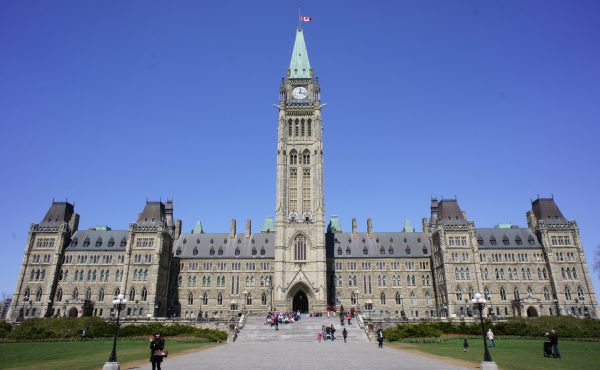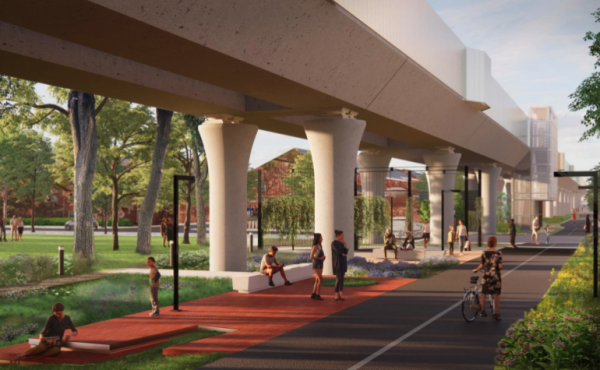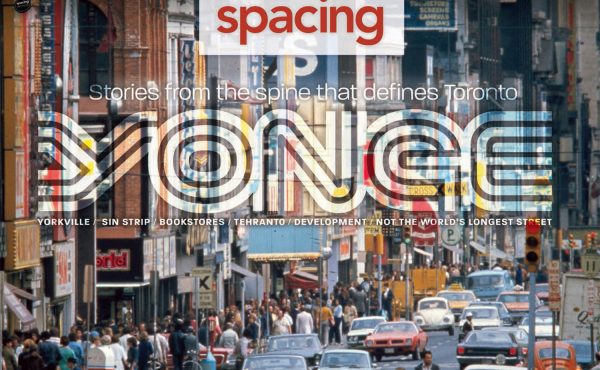
EDITOR: The following is commentary by Jon Robson, cross-posted from his tumblr. Robson is an amateur photographer and close municipal politics watcher. He lives in Leslieville. Photo by spDuchamp.
![]()
There are a number of different positions from which to criticize the development proposal put forward by the Toronto Port Lands Company and the Ford team, and it’s only natural that the ones which make the best headlines/jokes garner the most attention. But, these aren’t the same critiques which matter the most. It’s been said before but it bears repeating: This isn’t about the ferris wheel, or a monorail.
While it’s true that a lakeside hotel/mega-mall served by boat and monorail with a ferris wheel in its backyard is a laughably good example of the Ford’s well-documented capacity for city planning by astral projection, it and the somewhat more modest proposal delivered to the Executive Committee meeting yesterday afternoon, are a sideshow. Whether or not the Fords are deliberately misleading public opinion with their outrageous razzle-dazzle, or earnestly believe they’re on the right track, is beside the point. At this stage, what matters is that the Mayor and his inner circle are effectively hijacking the Toronto Port Lands Company/ TEDCO and pulling the rug out from underneath the current process of waterfront development in Toronto, a process which has a demonstrable track record of success and is earning the City money, right now. It also matters that they’re doing so in a tremendously opaque manner.
TEDCO, which has operated as the Toronto Port Lands Company since 2009, has a narrow and highly specialized mandate to arrange short-term leases for the lands which belong to City in the Port Lands, and to ensure that the industrial businesses which lease those lands operate within strict new environmental standards. This ‘caretaker’ role forms part of the overarching development strategy for the Waterfront – short-term leases ensure that the City will be able to develop the lands when the time comes, and because the lands will all need to be cleaned up prior to their eventual development, stringent environmental standards need to be enforced now to keep the extraordinary costs of soil remediation to a minimum.
Waterfront Toronto, meanwhile, has a mandate to partner with private sector developers to turn the underused lands along the bottom of Toronto into desirable and integrated components of our city. It has successfully been working towards that very goal for some time now, and the results are finally, finally being seen in the East Bayfront and West Don Lands (Corus Quay, Sugar Beach, Sherbourne Common/water treatment facility, a new condo designed by Moshe Safdie). Build Toronto works similarly, partnering with developers to re-zone and re-develop parcels of land which belong to the City, then leasing or selling them with an eye to increased ROI for the City. Profits from this process flow up to the City through annual dividends, and stand to generate hundreds of millions of dollars in profit for the City, over many, many years to come. This will help provide a long-term, though not indefinite, source of revenue for the City, as well as actively growing the tax base of the City (and the Province, and the Country) in a responsible and measured manner.
The guiding principle behind both Waterfront and Build’s mandate is that land is worth more — both at the point of sale and going-forward through property taxes and development charges — when it has been properly serviced and can be developed to maximum value, and maximum benefit to the City as a whole.
Much has been made, by the Mayor and his team, of the fact that there presently exists ‘no plan’ to pay for the flood protection work which is required as a basic prerequisite to the intensification and development of the Port Lands, but this is, perhaps unsurprisingly, an utterly dishonest half-truth. Waterfront has concluded a long-term, multi-million dollar Environmental Assessment of the Port Lands and the Don River flood plain and delivered the completed report in December of 2010. Additionally, Waterfront held an international design competition and has fully incorporated the input and advice of various stakeholders and community group in the region of the Port Lands in order to produce its plan. The ‘half-true’ part is simply what remains – lining up financing and starting to shape the mouth of the river.
The only reason there is ‘no plan’ for this yet because Waterfront Toronto wasn’t planning on bringing the Port Lands on-line this soon. The projects in the East Bayfront and West Don Lands are the first priority, and as anyone who’s ever taken an economics class will tell you, if all of the land in this corner of the city was made available at the same time, the resulting abundance of supply would wreak havoc on the profits the City stands to earn. Moreover, we wouldn’t have any more land to develop down the road. Last I checked, Toronto was planning on staying here, oh, indefinitely. City council voted unanimously to amend the Official Plan to meet Waterfront’s proposal for the mouth of the Don River, about a year ago. Today, the Chairman of Waterfront Toronto said: “There’s no question that the money is there to do it.”
Why hasn’t the Mayor, who is a board member of Waterfront Toronto by right, asked for the current plan to be stepped up? Why hasn’t he bothered to attend any of Waterfront’s board meetings since he has been in office?
At the Executive Committee meeting on Tuesday, Councillor Denzil Minnan-Wong made much of the fact that TPLC operates with a budget of $1.5M dollars and only employs a staff of 15. Given that the company is only supposed to arrange leases and implement environmental standards, I don’t suppose that’s too hard to believe. To be clear, TPLC is not intended as an alternate development agency along the lines of Waterfront Toronto, or Build Toronto.
Acting more-or-less unilaterally, the Fords appear to have authorized this corporation to retain CivicArts, a private-sector developer with a reputation for planning fantastical mega-projects in Kuwait (a one-kilometre high tower with a mosque, synagogue and a cathedral on top of three separate spires, anybody?) and Abu Dhabi, to run up an alternative development proposal which, in theory, will bring the Port Lands into play much more quickly then the 25 year build-out set out in the existing Waterfront Toronto plan. Did TPLC comply with the City’s rules and regulations regarding sole-sourced contracts when it awarded this gig to CivicArts? Is CivicArts taking the project on on spec? Where does Westfield, the Australia-based international mall developer fit in? What do local businesses think of these new plans? Has anyone asked the nearby BIAs? You see how quickly things get confusing when you don’t follow the rules or usual process?
Yesterday, the Toronto Star reported that a private citizen has filed a complaint under the City’s lobbying regulations seeking clarification of the relationship between Doug Ford and Westfield. Tonight, Westfield acknowledged that they were starting the paperwork to become registered lobbyists under those same regulations.
The Executive Committee also voted on Tuesday to ask Build Toronto, Invest Toronto and the TPLC to produce a list of senior management and their compensation, so that they may be added to the Province’s so-called ‘Sunshine List,’ the annually published list of the City’s employees and their salaries. Some would argue there’s never anything wrong with a little extra public disclosure, and generally, I wouldn’t disagree. However, entities such as Build and Invest are intended to be arms-length from the City, and consequently, the request is largely inappropriate and will likely serve to make those same senior management roles less desirable. I am inclined to believe there may be some tension between the management at Build at the Mayor’s office. In early August Build CEO Lorne Braithwaite gave an interview to the Star which ended:
“Braithwaite acknowledged that some councillors have asked him critical questions about how long and how much money it takes to develop a property rather than conduct a basic sale. But his response, he said, “has not been to say, ‘I’m going to fire-sale sites.’”
Build will “never” act as a mere real estate broker, he said. And even skeptics, he said, have come to accept his argument that patience will pay off.”
I suspect that remains to be seen. Does anyone else see a pattern emerging here?
Note: I’ve obviously relied heavily on the research, intuition and experience of others, to say nothing of the reporting of the Toronto Star, to educate myself of the subject of the City’s waterfront and the various machinations discussed above. To that end, I’d like to acknowledge the good work of: Daniel Dale, David Rider, Matt Elliott, Laurence Lui, Ed Keenan, Jonathan Goldsbie, Daren Foster and Jamie Woo.




12 comments
Has anyone even tried to write a serious defence of the Mayor’s waterfront “plan”? By serious, I mean something that addresses the concerns brought up here, mainly that it is utter madness to sell off maybe the most valuable land in the country to make one-time debt/deficit payments?
Earlier in the week John Lorinc’s piece did actually point to one or two ok things in the plan….
Like it or not, Waterfront Toronto is essentially in a position where they need to justify their plan when they present to Council in a couple of weeks.
What I think they should do (in part) is present a comparison of the revenue the city will receive over the next 50 years from each plan. This would compare the land sale revenue (likely higher in WT’s plan), the property tax revenue (possibly higher in Ford’s plan, since it will occur over a longer period of time), etc.
If the number’s work out in WT’s favour, that would go a long way towards justifying their plan in the eyes of the current council.
While I personally believe the decision should be about what’s right for the city and not just the numbers, when talking to this council I think the numbers are almost a necessity.
I think any numbers brought to council on September 21, by any party to this discussion, will likely be highly speculative at this stage, unless Westfield/CivicArts already have numbers of their own. If they do, and it’s mind-bendingly difficult to understand how they possibly could in the absence of an RFP for reference, then the obvious question should be: how are their numbers substantiated? Waterfront shouldn’t have as tough a time backing their plan up with specifics.
Having said that, all that really needs to happen is people need to lean on the 6-9 people on council who are at all uncertain as to how they might vote on the matter.
The Fords like going over the budget looking for anything that brings in revenue, then getting rid of it. If the goal is to bankrupt the city, they’re on the right track.
Not to mention the hugh parking lots a mega-mall will require. Might be some lost tax revenue there! Unless all the shoppers are to be delivered by monorail?
Someone should point out that in Battery Park City in New York, really the best comp for Toronto Waterfront, the government never sold the land. What they did was leased it for 99 yrs to developers, who then built condos and rentals on top of it. That very European solution generated revenue without giving away ownership of prime land.
So I found this half-hearted apology for the Fords’ plan from Marcus Gee from last week:
http://www.theglobeandmail.com/news/national/toronto/marcus-gee/doug-fords-ferris-wheel-idea-not-so-loopy-after-all/article2152821/
The gist of his argument is, “maybe it is a good idea to have another look at the current plans and see if we can’t squeeze some more money out of the land”.
And sure, that’s a reasonable argument, except, that’s not what the Fords are trying to do. They want their own plan, damn the past!
Then he offers the simplistic argument that the naturalization of the mouth of the Don will remove valuable development land and cost so much that it simply will not happen in these difficult economic times. He neglects to mention that Waterfront Toronto chose the most cost-efficient (according to them) method of flood protection, and that WT can borrow the money to build the river and repay it from property taxes, etc.
Enough gnashing of teeth and trying to win the day through measured debate. The Fords are bullies. Treat them like a bully. Given all the rules they’ve broken, it should be easy to get a court injunction to stop their process. When is someone going to hire a lawyer? That’s the only way you’ll make them stop.
As it stood the water front was going to become just another sea of condos. Torontos development charges will not cover the costs inncurred by the city and residential development costs more to provide services than they generate in taxes. It is not enough to simply look at an expanding tax base while ignoring operating costs.
The wt plan was nothing more than a giant subsidy to condo developers. Any change that would put more commercial and less residential development should be welcomed.
Jonathan has so many points backwards! Build Toronto has done practically nothing in its 2.5 years of existence. Except sell one peice of property on Front Street East owned by the city. They did not re-zone it, nor redevelop it nor joint venture… they just sold it as is. The CEOs at Build Toronto (and Invest Toronto) are rumoured to make over $330 plus a bonus of 40%! Way higher than the City Manager who is responsible for some 70,000 workers and a 9 billion dollar annual budget. So how can Jonathan Robson praise these corporations as having accomplished things when they have clearly not? Unfortunately it puts his views about Waterfront Toronto into question when he is such a fan of two other expensive corporations that have little or nothing to show for their expense.
http://codeblueto.com. Supporting the people’s plan for Toronto’s waterfront. sign the petition!